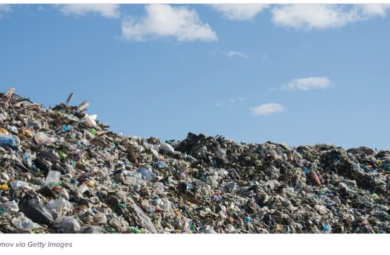In a joint US/EU press release on the Global Methane Pledge, just days before COP26, landfills were cited as one of the three main sources of methane emissions. The EPA has recently stated that methane emissions from landfills may be understated by a factor of two. The agency has proposed regulations that would require more landfills to install methane capture systems, a step that will result in a small decrease in emissions, but one that does not address the problem. We believe that the best approach is the one that much of Europe has already taken, with proven results: stop the landfilling of municipal solid wastes altogether.

– The EPA has stated it believes estimates of methane emissions from landfills may be twice as high as models indicate. While the landfill industry might disagree, numerous field studies have found that methane emissions are actually much higher than estimated. A 2016 study by Germany’s Institute for Energy and Environmental Research identified that landfill operators’ claims of methane recovery left out substantial amounts of emissions.
-Waste management companies are no longer just local contractors and the largest landfill operators are now national publicly traded companies. Substantial sums have been spent at the federal and state level by the waste management industry to influence the development and implementation of regulations. It is clear that waste companies have a vested interest in maintaining the status quo, and are willing to spend to do so.
-As more and more people come to realize the urgency of the climate crisis and the need for real and significant action, the U.S. must follow suit. As European Union Commission President Ursula von der Leyen said before the opening of the COP26 conference in Glasgow, now comes the “moment of truth” that will affect the “survival of mankind.”
Stop all land application of “biosolids”:Land application of sludge that contains PFAS, including composted sludge, is not safe.
Continuing to allow this practice will result in water contamination and destroy land for future use as farmland. As farmers in Maine and elsewhere have discovered, once contaminated with PFAS, it is virtually impossible to make soils safe for farming. While EPA has taken initial steps that could change how PFAS-contaminated wastes are regulated in the future, the timing and scope of any changes are up in the air. There is no indication yet that EPA plans to revisit its biosolids rule. States have the authority to act, and doing so will incentivize the removal of PFAS from wastewater discharges and consumer products and prompt speedier development of safe PFAS destruction technologies.
There is another source of fugitive methane emissions that should also be addressed: landfills. A study conducted by NASA in 2019 for the State of California found that landfills were a major source of methane, greater than the agriculture and oil and gas sectors. Even facilities with landfill gas capture systems emit significant amounts of methane. Compared to other industries, landfills are very loosely regulated, and monitoring requirements are low.
There is another source of fugitive methane emissions that should also be addressed: landfills. A study conducted by NASA in 2019 for the State of California found that landfills were a major source of methane, greater than the agriculture and oil and gas sectors. Even facilities with landfill gas capture systems emit significant amounts of methane. Compared to other industries, landfills are very loosely regulated, and monitoring requirements are low.
